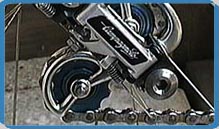|
To Do:
Shift the gears so that the chain is on the
smallest cog in the front, and on the largest cog
in the back.
Mark the top of the rear tire
with the chalk, or with a piece of tape.
Note the position of the pedals.
Have someone hold the bike upright as you turn the
pedals one full revolution, so that the pedals
return to their original position.
How many times did the rear tire
revolve? Write down the number of revolutions.
(Note: you may have to have a friend control the
rear tire with his hand, so that the tire does not
spin freely past the point that the pedals pushed
it to.)
Now try the largest gear in
front combined with the smallest gear in the rear.
How many times does the rear wheel revolve for one
turn of the pedals?
Which of these combinations
would be better for climbing a hill? Which would be
better for a sprint on a flat road? (You can test
your guesses later by riding the bike!)
Experiment with the intermediate
gear ranges. Make a chart of the number of rear
wheel revolutions each combination of gears
produces for one pedal revolution. Why do you think
bikes have evolved to have more and more
gears?
|
The Campagnolo
Story

|
|
One of the first and most
renowned bicycle parts makers was
the Campagnolo family. Tullio
Campagnolo (1902-1983) founded
the Campagnolo Company, which has
made quality parts for over 50
years. Tullio is credited with
perfecting the modern
parallelogram derailleur, and
inventing the quick-release
mechanism for wheels. Legend has
it that Campagnolo, a pro racer,
was leading a race through
Italy's snowy Dolomite Mountains
when he punctured a tire on a
descent. Fumbling with frozen
fingers trying to loosen the
heavy wing nuts on his wheel, he
was passed by a score of riders.
Infuriated by this experience, he
designed a hollow-axle
quick-release mechanism which is
used on almost every bike
today.
The quality of Campagnolo
component sets, or "grouppos,"
has become legendary, along with
their cost. Though some
questioned whether the sets were
worth the price, afficionados
would use nothing else.
Cost-conscious alternatives were
often referred to as
"Cramp-and-go-slow" as opposed to
the dependable, smooth-shifting
Campagnolo. And though the
component market has been
dominated in the past decade by
the giant Japanese company
Shimano, "Campy" still finds its
niche at the high end of the
performance scale.
|
|
|